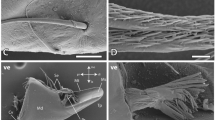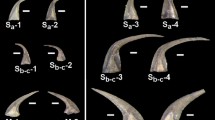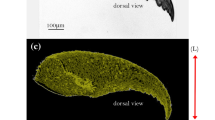Abstract
A number of arthropod taxa contain metals in their mandibles (jaws), such as zinc, manganese, iron, and calcium. The occurrence of zinc and its co-located halogen chlorine have been studied in relation to the mechanical properties and shown to be linked in a direct fashion with increasing concentration. Hardness along with elastic modulus (stiffness) has also been linked to zinc and halogen concentration in some marine polychaete worms. The metal appears to be incorporated within the biological matrix, possibly bonding with proteins. However, the comparative advantage of metal inclusion has not been tested. It is possible that without metals, alternative mechanisms are used to achieve hardness of equal value in similar ‘tools’ such as mandibles. This question has direct bearing on the significance of metal hardening. In the present article, we compare across mandibles from six termite species, including samples with major zinc concentration, minor manganese, and no metals. Nanoindentation, electron microscopy, and electron microanalysis are used to assess metal concentration, form, and mechanical properties. The data demonstrate that termite mandibles lacking metals when fully developed have lower values for hardness and elastic modulus. Zinc is linked to a relative 20% increase in hardness when compared with mandibles devoid of metals. The similar transition metal, manganese, found in minor concentrations, is not linked to any significant increase in these mechanical properties. This raises the question of the function of manganese, which is as commonly found in insect mandibles as zinc and often located in the same mandibles.




Similar content being viewed by others
References
Birkedal H, Khan RK, Slack N, Broomell C, Lichtenegger HC, Zok F, Stucky GD, Waite JH (2006) Halogenated veneers: protein cross-linking and halogenation in the jaws of Nereis, a marine polychaete worm. ChemBioChem 7:1392–1399
Cribb BW, Rasch R, Barry J, Palmer CM (2005) Distribution of calcium phosphate in the exoskeleton of larval Exeretonevra angustifrons Hardy (Diptera: Xylophagidae). Arthropod Struct Dev 34:41–48
Edwards AJ, Fawke JD, McClements JG, Smith SA, Wyeth P (1993) Correlation of zinc distribution and enhanced hardness in the mandibular cuticle of the leaf-cutting ant Atta sexdens rubropilosa. Cell Biol Int 17:697–698
Fawke JD, McClements JG, Wyeth P (1997) Cuticular metals: quantification and mapping by complementary techniques. Cell Biol Int 21:675–678
Fontaine AR, Olsen N, Ring RA, Singla CL (1991) Cuticular metal hardening of mouthparts and claws of some forest insects of British Columbia. J Entomol Soc Brit Columbia 88:45–55
Goldstein J, Newbury DE, David C, Joy DC, Lyman CE, Echlin P, Lifshin E, Sawyer LC, Michael JR (2003) Scanning electron microscopy and x-ray micronalysis, 3rd edn. Kluwer, New York
Hillerton JE, Vincent JFV (1982) The specific location of zinc in insect mandibles. J Exp Biol 101:333–336
Hillerton JE, Reynolds SE, Vincent JFV (1982) On the indentation hardness of insect cuticle. J Exp Biol 96:45–52
Hillerton JE, Robertson B, Vincent JFV (1984) The presence of zinc or manganese as the predominant metal in the mandibles of adult, stored-product beetles. J Stored Prod Res 20:133–137
Lichtenegger HC, Schoberl T, Ruokolainen JT, Cross JO, Heald SM, Birkedal H, Waite JH, Stucky GD (2003) Zinc and mechanical prowess in jaws of Nereis, a marine worm. Proc Natl Acad Sci U S A 100:9144–9149
Morgan TD, Baker P, Kramer KJ, Basibuyuk HH, Quicke DLJ (2003) Metals in mandibles of stored products insects: do zinc and manganese enhance the ability of larvae to infest seeds. J Stored Prod Res 39:65–75
Newbury DE (1991) Standardless quantitative electron-excited x-ray microanalysis by energy-dispersive spectrometry: what is its proper role. Microsc Microanal 4:585–597
Oliver WC, Pharr GM (1992) An improved technique for determining hardness and elastic modulus using load and displacement sensing indentation experiments. J Mater Res 7:1564–1583
Perry CC, Grime GW, Watt F (1988) An X-ray analytical study of mandibles from Calanus pacificus, an herbivorous copepod. Nucl Instrum Methods Phys Res, Sect B 30:367–371
Quicke DLJ, Wyeth P, Fawke JD, Basibuyuk HH, Vincent JFV (1998) Manganese and zinc in the ovipositors and mandibles of hymenopterous insects. Zool J Linn Soc 124:387–396
Schöberl T, Jäger IL (2006) Wet or dry-hardness, stiffness and wear resistance of biological materials on the micron scale. Adv Eng Mater 8:1164–1169
Schofield RMS (2001) Metals in cuticular structures. In: Brownell P, Polis G (eds) Scorpion biology and research. Oxford University Press, Oxford, pp 234–256
Schofield R, Lefevre H (1989) High concentrations of zinc in the fangs and manganese in the teeth of spiders. J Exp Biol 144:577–581
Schofield RMS, Nesson MH, Richardson KA (2002) Tooth hardness increases with zinc-content in mandibles of young adult leaf-cutter ants. Naturwissenschaften 89:579–583
Schofield RMS, Nesson MH, Richardson KA, Wyeth P (2003) Zinc is incorporated into cuticular “tools” after ecdysis: the time course of the zinc distribution in “tools” and whole bodies of an ant and a scorpion. J Insect Phys 49:31–44
Vincent JFV, Wegst UGK (2004) Design and mechanical properties of insect cuticle. Arthropod Struct Dev 33:187–199
Yoshimura T, Kagemori N, Kawai S, Sera K, Futatsugawa S (2002) Trace elements in termites by PIXE analysis. Nucl Instrum Methods Phys Res, Sect B 189:450–453
Yoshimura T, Kagemori N, Sugiyama J, Kawai S, Sera K, Futatsugawa S, Yukawa M, Imazeki H (2005) Elemental analysis of worker mandibles of Coptotermes formosanus (Isoptera: Rhinotermitidae). Sociobiology 45:255–259
Acknowledgements
We gratefully acknowledge supply of some termite samples from Dr Michael K. Rust, Department of Entomology, UCR, Riverside, USA; Dr B. Peters, Queensland Department of Primary Industries and Fisheries; and Mrs Rachel Hancock Narangbar, Queensland, Australia. HH is grateful for experimental assistance by Mr. B. L. Wang at the University of Queensland, Brisbane, Australia. The experiments comply with the current laws of the country in which they were performed.
Author information
Authors and Affiliations
Corresponding author
Rights and permissions
About this article
Cite this article
Cribb, B.W., Stewart, A., Huang, H. et al. Insect mandibles—comparative mechanical properties and links with metal incorporation. Naturwissenschaften 95, 17–23 (2008). https://doi.org/10.1007/s00114-007-0288-1
Received:
Revised:
Accepted:
Published:
Issue Date:
DOI: https://doi.org/10.1007/s00114-007-0288-1




